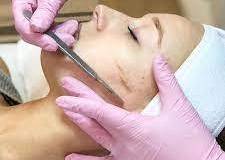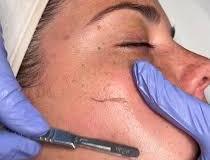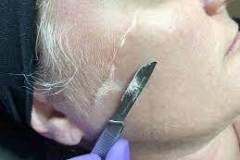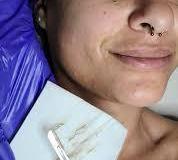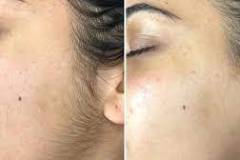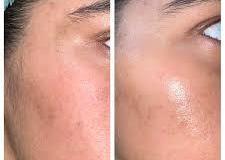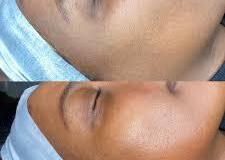| Time (in minutes) | Amount |
|---|---|
| 60 | $99 |
What is it
Dermaplaning is a cosmetic skin treatment that involves using a surgical scalpel to gently scrape off the top layer of dead skin cells and vellus hair, commonly known as “peach fuzz,” from the face. This process helps to reveal smoother, brighter, and more even-toned skin, and can also enhance the effectiveness of other skincare treatments.
It is gentle enough to be done by itself, or with another service: oxygeneo, microneedling or a facial.
Commonly Asked Questions
Who can get it?
Dermaplaning is generally safe for most skin types and ages, but there are some considerations to keep in mind before deciding if it’s right for you. Here are some factors to consider:
It is great for helping with:
- Acne scars
- Dry/Dull skin
- Peach Fuzz
Your skin will feel smooth and look even with dermaplaning. Skin care products and makeup will go on much smoother.
Who Shoudnt Get It?
We always recommend getting a consultation done before hand to see if the service is right for you.
Here are some conditions we can not work over:
- Active acne/Cystic acne
- Cold sore breakouts
- Eczema
- Moles/Skin tags or skin growths
- Skin Rashes
- Sunburns
What Are The Benefits?
We usually recommend one session a month.
- Removes build-up of dead skin cells
- Promotes cell turnover
- Improved skin texture and tone
- Smoother, brighter complexion
- Enhanced absorption of skincare products
- Reduction in the appearance of fine lines and wrinkles
- Removal of vellus hair and dead skin cells
- Safe and effective for most skin types
What To Expect After?
After a dermaplaning treatment, you may experience some mild redness and sensitivity, similar to a light sunburn. This is normal and should subside within a few hours to a day. Here are some other things you can expect after a dermaplaning treatment:
- Smooth, glowing skin: You should notice an immediate improvement in the texture and appearance of your skin, as the treatment removes the top layer of dead skin cells.
- Enhanced absorption of skincare products: Because dermaplaning removes the top layer of dead skin cells, your skincare products will be able to penetrate deeper into the skin, making them more effective.
- Sun sensitivity: Your skin may be more sensitive to the sun following treatment, so it’s important to wear sunscreen and avoid prolonged sun exposure.
- Temporary hair removal: Dermaplaning removes vellus hair or “peach fuzz” from the face, but the hair will grow back at the same rate and texture as before.
- No downtime: Dermaplaning is a non-invasive treatment and requires no downtime, so you can resume your normal activities immediately after the treatment.
It’s important to follow your aestheticians aftercare instructions, which may include avoiding makeup for a few hours after the treatment and using gentle skincare products to avoid irritation. It’s also important to protect your skin from the sun and avoid any aggressive exfoliation for a few days following the treatment.
What is Dermaplaning?
Dermaplaning is a treatment that uses a medical scalpel to gently exfoliate the outer layer of dead skin cells and removes fine vellus hair, commonly known as “peach fuzz”.
It can be used as an alternative to laser treatments and microdermabrasion or alongside them for enhanced results. This procedure will give your skin a more radiant appearance and smooth texture. Following the treatment, makeup application is smoother and other skincare products are able to penetrate deeper into the skin in turn, making them more effective.
Am I a good candidate?
Dermal landing is safe for all skin types, and is sometimes advised as a more gentle form of exfoliation for pregnant/nursing women or those with sensitive skin. Dermaplaning can also help reduce the appearance of shallow acne scars, fine lines and superficial hyperpigmentation.
Is the treatment safe?
This treatment is extremely safe when performed by a properly trained skincare professional. There is no more risk to the skin than when you shave your legs. There is also no downtime associated with this procedure making it desirable to many individuals looking for immediate results with no downtime.
Does it hurt? Will it cause cuts?
Dermaplaning is effective by performing a gentle scraping motion across the skin’s surface and is entirely painless. There are risks of cuts on the skin, however they are small and very minor as the pressure used for Dermaplaning cannot cause a deep cut. These nicks and scrapes are rare but do heal within 24-48 hours just as it would when shaving with a razor.
Will it make the hair on my face grow back thicker and darker?
No. This is a common misconception. There are different types of hair that grow on the body; vellus hair and terminal hair. Vellus hair is found on most areas of the body, whereas terminal hairs are found on the scalp, underarms and pubic region. The soft and fine vellus hair grows back at the same rate and texture always whereas terminal hair can grow back more coarse.
What is the benefit of adding a chemical peel with Dermaplaning?
Hyperkeratosis is a build up of dead skin cells on the skin’s surface. By removing this initial layer, a chemical peel is able to penetrate deeper into the dermis resulting in a more effective treatment. The conjunction of dermaplaning and a chemical peel leaves the skin refreshed and rejuvenated. Together they promote new skin growth and target problems such as aging, sun spots and environmental damage.
What is the difference between dermaplaning and microdermabrasion?
Both options are a form of physical exfoliation. Dermaplaning removes vellus hair (peach fuzz) and dead skin cells from the skin, whereas microdermabrasion exfoliates the surface of the skin, but not quite as thoroughly or as deeply as dermaplaning does.
How long is the treatment? How often can I have it done?
Dermaplaning takes anywhere between 30-45 minutes and can be performed every 3-4 weeks. The treatment itself removes dead skin so it is important to let your skin repair itself and rejuvenate before your next appointment.
Instructions
Pre-Care Instructions
1. Avoid Sun Exposure: Minimize sun exposure and use sunscreen regularly in the weeks leading up to your dermaplaning treatment. Sunburned or tanned skin should not undergo dermaplaning.
2. Avoid Skin Sensitizing Treatments: Refrain from using exfoliating products such as scrubs, retinoids, acids, or enzymes for at least one week before your dermaplaning session.
3. Avoid Shaving and Waxing:If you typically shave or wax your face, it’s important to stop these activities a few days before dermaplaning to ensure the skin is not irritated or compromised.
Post-Care Instructions
1. Avoid Sun Exposure: After dermaplaning, the skin may be more susceptible to sun damage. Apply a broad-spectrum sunscreen with at least SPF 30 and limit sun exposure for a few days following the procedure.
2. Gentle Cleansing: Use a gentle cleanser to cleanse the face after dermaplaning. Avoid using harsh scrubs or masks that may irritate the skin.
3. Moisturize: Apply a hydrating moisturizer to soothe and nourish the skin or cool aloe vera gel.
4. Avoid Makeup: It is recommended to avoid wearing heavy makeup for the first 24-48 hours after dermaplaning to allow the skin to breathe.
5. Sun Protection: Even after the initial post-care period, continue to protect your skin from the sun by using sunscreen daily.

